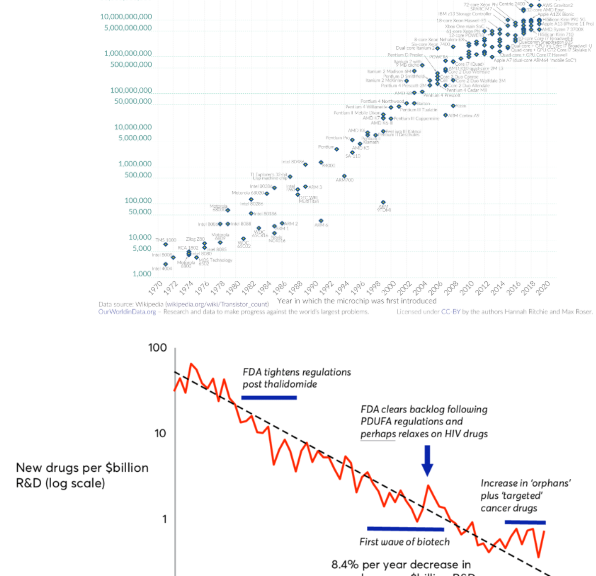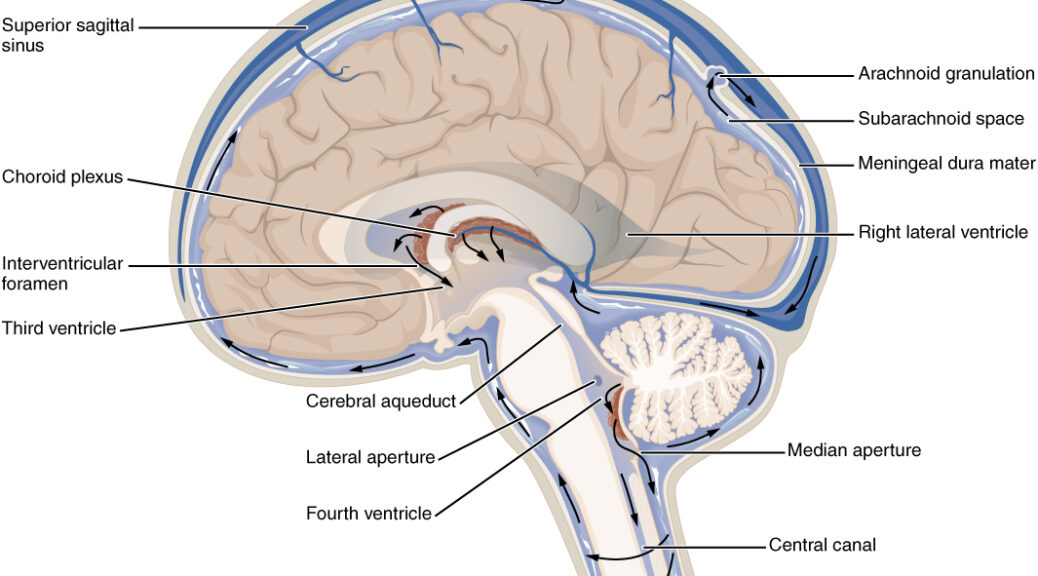“It’s less that there are strong arguments why death is good,” he argues, “but what I call palliative philosophy: death is inevitable, we want convincing reasons as to why that’s good, so we create them. In fact, we spend vast amounts globally on healthcare and medical research.” It makes up 10% of global economic activity. “Modern medicine is really the practice of trying to keep death at bay. But we haven’t yet acknowledged or agreed – as a society – that the end goal of medical research is actually to eliminate disease completely. Dr Ariel Zeleznikow-Johnston, neuroscientist, The Guardian, December 1st, 2024.
This month’s theme: Eroom’s Law and Moore’s Law
What is Moore’s law (conjecture)? Is it still holding?
Moore’s law was formulated by Gordon Moore, co-founder of Intel, in 1965. He posits that the number of transistors on a microchip doubles approximately every two years, leading to a corresponding increase in computing power and a decrease in relative cost. This exponential growth has been a fundamental driver of the rapid advancement in electronic and computing technologies over the past several decades. The consistent doubling of transistors has created smaller, more powerful, and cost-effective computing devices, spurring innovation and productivity across multiple sectors. However, maintaining the pace predicted by Moore’s Law has become increasingly challenging due to physical and economic limitations.
Moore’s Law is not a law. It is an observation and became a rule for the industry. It has influenced strategic planning and research and development efforts within the technology industry, shaping the direction and focus of innovation. Despite the challenges in maintaining its pace, Moore’s Law remains a cornerstone of technological progress. Its impact on the evolution of computing and electronics continues to be profound, ensuring that the principles of rapid improvement and cost reduction remain integral to the industry’s advancement. The end of the law has been announced in the past and is still announced. The general concept of exponential growth of technological capacities is also popular in other fields. Some longevists used it to announce “exponential” progress in longevity. For example, Ray Kurzwzeil announced In the Age of Spiritual Machines (1999), Kurzweil predicted that the life expectancy would reach about 100 in 2019. Sadly, until now, the trend has not been the same for longevity. And for the pace of healthcare therapies, we see a disappointing evolution.
Eroom’s Law
Eroom’s Law, named by ironically reversing the name “Moore,” is a concept in pharmaceutical research and development (R&D) that highlights the increasing inefficiency and costliness of drug (and therapies) discovery over time. Unlike Moore’s Law, which observes the exponential improvement in computing power, Eroom’s Law points to a trend where the number of new drugs approved per billion dollars spent on R&D has halved approximately every nine years since the 1950s. It is now estimated that the total cost of the creation of a new drug reaches an astronomical amount of 2 billion dollars.
Eroom’s Law was described by Jack W. Scannell and colleagues in a 2012 paper in Science. They documented the declining productivity in drug R&D despite technological advancements and increased investments. They noted that while the investment in R&D has grown exponentially, the output in terms of new drug approvals has not kept pace, leading to a paradoxical decline in productivity. What is causing this?
- The “Better than the Beatles” Problem refers to the increasing difficulty of surpassing the therapeutic effectiveness of existing drugs. As more effective treatments are developed, new drugs must demonstrate significant improvements over these high benchmarks, discovering truly novel and superior treatments more challenging. It is also said that “low-hanging fruits are plugged first”.
- Regulatory requirements have become more stringent over time, aiming to ensure drug safety and efficacy. While this improves patient safety, it also increases the time, cost, and complexity of bringing a new drug to market. The demand for extensive clinical trials and post-market surveillance contributes to higher R&D costs. Pharmaceutical companies often increase R&D budgets in response to declining productivity. However, this can lead to diminishing returns. There has also been a shift towards high-throughput screening and other brute-force methods in drug discovery. This focus on quantity over quality can dilute efforts and resources.
- “Regulatory Ratchet”. Over time, regulations tend to become more stringent. Each safety issue or scandal leads to new regulations, which accumulate and increase the burden on R&D processes. There is a radical disproportion between the wide attention to negative consequences of the testing of new therapies and the limited attention to lost lives because of the slowness of medical research. One of the reasons is that a victim of a clinical trial is generally a healthy person and always a person benefiting from higher attention. And a victim of a medical mistake is a well-defined person while the victims of non-discoveries will remain unknown.
- The growth of bureaucracy, for-profit industry, and legal complexity. Time dedicated to research in the research sector is diminishing constantly. When you follow the information about longevity research, you will see more claims of new patents than claims of new therapies, more announcements of the creation of start-ups than announcements of new drugs, more demands for new funding than offers for new posts of researchers… Maybe the most disastrous situation is the multiplication of litigations and lawyers opportunities. The goal is seldom to save lives, but almost always to prove that somebody has to pay somebody else for a medical reason and, of course, to pay the lawyers (and the ever-growing services related) who “demonstrated” the situation.
Eroom’s law has significant implications for longevity research. The declining productivity may deter public and private investment in innovative therapy research.
How to accelerate the finding (and approval) of new therapies? Will AI Beat The Eroom’s Law?
Addressing Eroom’s Law requires multifaceted strategies:
- Streamlining regulatory processes and adopting adaptive regulatory frameworks can help balance safety with innovation.
- Leveraging advanced technologies like artificial intelligence, machine learning, and big data can enhance predictive accuracy and streamline drug discovery.
- Partnerships between academia, industry, and regulatory bodies to facilitate knowledge sharing and reduce duplication of efforts must be encouraged. This includes:
- The publication of “negative” results
- Less bureaucracy
- Fewer patents and more open results
- More researchers, and fewer lawyers
One key question is -of course- how fast medical AI will accelerate research for healthy longevity. It depends on how much AI will be a priority for human longevity. In the domain of artificial intelligence (and increasingly artificial general intelligence), we live in times, that are fascinating, but that can be dangerous. Safe AI and medical longevity research are not directly related. However, making healthy resilience a common goal for the development of AI is a part of proactive work towards a better and more secure world.
The interesting news of the month: Startling nominations announced in the new US administration
You may not like the newly elected president of the USA. However, concerning health, his presidency could bring interesting evolutions. The announced Secretary of Health Robert Kennedy is a very controversial person having positions that do not conform to recognized scientific views. But the chosen No. 2, future Deputy Secretary of Health will be Jim O’Neill. He is a long-time longevist and was CEO of the longevity organization SENS Research Foundation.
Even more important is the announced nomination of Elon Musk and Vivek Ramaswamy. for a radical simplification of administrations through a new Department of Government Efficiency (DOGE). FDA included. Musk and Ramaswamy have radical views in many domains, including concerning scientific research. It remains to be seen if the general trend will be a destructive or a regenerative one.
For more information
- Heales, Longevity Escape Velocity Foundation, International Longevity Alliance, Longecity, and Lifespan.io
- Heales Monthly Science News
- Heales YouTube channel
- Source of the graphs: Moore’s_Law_Transistor_Count_1970-2020.png and
- Eroom’s law the number of new molecule -approved by-the FDA_fig4
- Contact us




